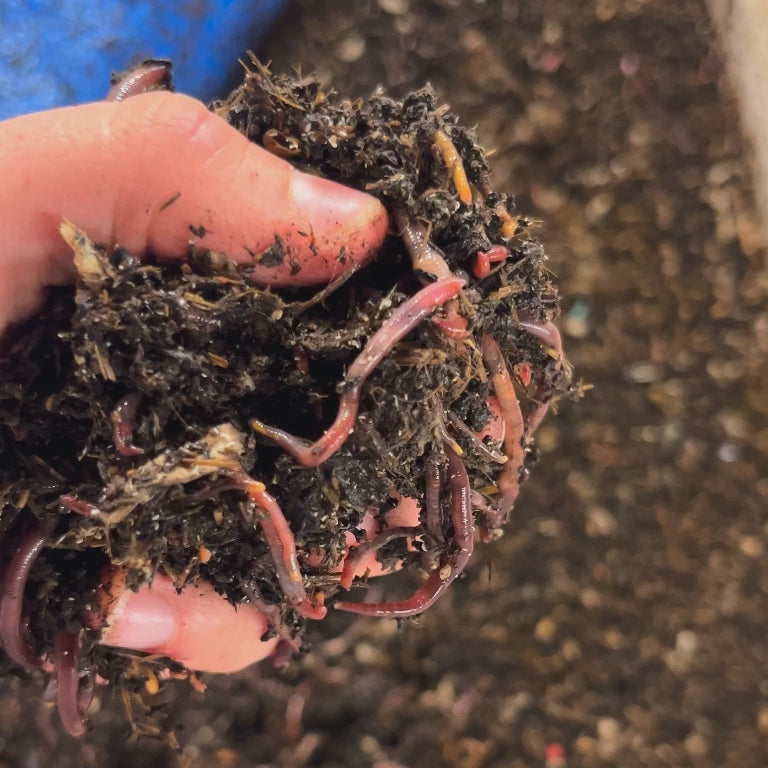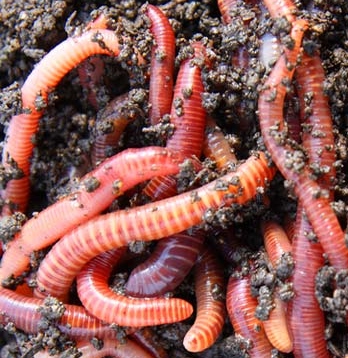Recognizing the Perks of Red Wiggler Composting: How This Reliable Method Changes Organic Waste Into Nutrient-Rich Soil Changes
Red Wiggler composting, utilizing the varieties Eisenia fetida, offers a compelling method to organic waste management, transforming cooking area scraps and backyard particles right into valuable dirt modifications. This method not only improves soil fertility however likewise addresses pressing environmental worries, consisting of land fill waste decrease and greenhouse gas exhausts.
What Are Red Wigglers?
Red wigglers, medically called Eisenia fetida, are a varieties of earthworm that play a pivotal role in vermicomposting systems. These worms are characterized by their reddish-brown color, segmented bodies, and a distinct ability to grow in organic-rich environments, making them suitable for composting applications - Red Wiggler Composting. Unlike their garden-dwelling counterparts, red wigglers like to populate the upper layers of soil, where decomposing issue is plentiful
Normally determining in between 3 to 4 inches in size, red wigglers have a high reproductive price, enabling them to multiply swiftly under ideal conditions. They have an one-of-a-kind digestion system that enables them to process natural waste effectively, converting it into nutrient-rich spreadings, which are extremely advantageous for plant development.
Their resistance to varying dampness levels and temperature varies even more enhances their energy in vermicomposting setups, making them a popular option among composting fanatics. In addition, red wigglers are aerobic microorganisms, which requires a well-aerated composting setting, making sure effective disintegration. Comprehending the organic qualities and behaviors of red wigglers is necessary for optimizing their usage in sustainable waste administration practices.

Benefits of Vermicomposting
Using the power of vermicomposting offers a plethora of environmental and farming advantages. It significantly minimizes natural waste in land fills, thereby lessening methane exhausts, a powerful greenhouse gas. By diverting food scraps and yard waste to vermicomposting, we support an even more lasting waste monitoring system.
Additionally, vermicomposting improves soil health and wellness. The spreadings generated by red wigglers are abundant in important nutrients, microorganisms, and enzymes, enhancing dirt framework and fertility. This nutrient-rich modification advertises durable plant development and raises water retention, reducing the need for chemical fertilizers.
Furthermore, vermicomposting fosters biodiversity in the soil environment. The intro of helpful microbes from worm spreadings help in condition reductions and nutrient biking, producing a healthier atmosphere for plants.
Economically, vermicomposting reduces the costs connected with chemical inputs and waste disposal. Farmers and garden enthusiasts can grow high-grade fruit and vegetables at reduced expenses, adding to food safety and sustainability.
Exactly How to Begin Composting
Starting a composting venture can be a rewarding and simple procedure. To start, choose an appropriate location that is well-drained and obtains partial sunshine. This will help keep a well balanced temperature level, critical for the composting procedure. Next, choose a garden compost bin or create a marked location in your garden, guaranteeing it is conveniently available for adding products and gathering garden compost.
Collect read more organic products such as kitchen area scraps, lawn waste, and shredded paper. Goal for a balanced mix of 'eco-friendly' materials, high in nitrogen (e.g., fruit scraps, coffee grounds), and 'brownish' materials, abundant in carbon (e.g., dried fallen leaves, cardboard) A proportion of roughly 2:1 green to brown products is suitable.
Start layering your products, ensuring appropriate air flow by turning the pile on a regular basis. This promotes aerobic decomposition, lowering odors and speeding up up the procedure. Screen moisture degrees; the compost should seem like a moist sponge but not excessively wet.
Nutrient Profile of Vermicompost
Composting, particularly with red wigglers, yields a nutrient-rich item called vermicompost. This organic amendment is differentiated by its high focus of essential nutrients, making it an invaluable resource for horticulture and farming. Vermicompost typically includes elevated levels of macronutrients such as nitrogen, phosphorus, and potassium, which are important for plant development. In addition, it supplies trace elements like calcium, magnesium, and iron, fostering robust plant growth and boosting dirt wellness.
The microbial learn the facts here now task present in vermicompost even more enriches its profile, introducing valuable microorganisms and fungi that promote vitamins and mineral accessibility and uptake in plants. This biological part help in suppressing plant conditions and boosting soil framework, bring about boosted water retention and oygenation.

Environmental Effect of Composting
The environmental influence of composting, particularly with using red wigglers, is extensive and multifaceted. This method substantially decreases the volume of organic waste sent to land fills, which subsequently lessens greenhouse gas exhausts, especially methane-- a potent factor to climate modification. By diverting natural materials from garbage dumps, red wiggler composting not just aids alleviate environmental degradation but additionally advertises lasting waste monitoring methods.

Additionally, composting adds to carbon sequestration, as the procedure records co2 from the atmosphere and stores it in the soil. This natural procedure help in combating environment adjustment while improving the soil - Red Wiggler Composting. In general, red wiggler composting provides a practical, environment-friendly option for waste administration and ecological sustainability, promoting healthier ecosystems and a more sustainable future
Final Thought
In final thought, Red Wiggler composting works as an effective method for my site transforming natural waste into important soil modifications. The procedure not only improves soil fertility and framework however likewise reduces ecological concerns connected with waste disposal. By utilizing Eisenia fetida, this kind of vermicomposting adds to improved biodiversity and sustains lasting agricultural techniques. Eventually, Red Wiggler composting plays a vital duty in promoting healthier ecosystems and addressing the obstacles of climate adjustment.
Red Wiggler composting, employing the types Eisenia fetida, presents an engaging strategy to organic waste management, transforming cooking area scraps and backyard debris into important soil amendments. Unlike their garden-dwelling counterparts, red wigglers like to inhabit the upper layers of dirt, where decomposing issue is bountiful.
The castings generated by red wigglers are rich in necessary nutrients, microbes, and enzymes, enhancing dirt structure and fertility. The nutrient-rich by-products of red wiggler task improve soil structure, boost water retention, and advertise biodiversity within the soil environment.In verdict, Red Wiggler composting serves as an efficient approach for converting organic waste right into beneficial soil changes.